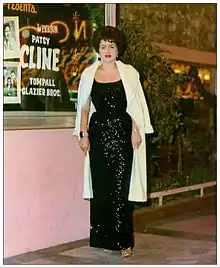Bouffant
A bouffant /buːˈfɒnt/ is a type of hairstyle characterized by hair raised high on the head and usually covering the ears or hanging down on the sides.

b.png.webp)


Etymology
The English word bouffant comes from the French bouffante, from the present participle of bouffer: "to puff, puff out".
History
The bouffant was a mainstream hairstyle in the mid-to-late 18th century in Western Europe. It was thought to be created for Marie Antoinette, as she had relatively thin hair and wanted to create the illusion of having very full hair.
The modern bouffant, considered by one source to have been invented by British celebrity hairdresser Raymond Bessone[1] was noted by Life in the summer of 1956 as being "already a common sight in fashion magazines."[2]
The style became popular at the beginning of the 1960s when First Lady Jacqueline Kennedy was often photographed with her hair in a bouffant, and her style was widely imitated.[3][4] Generally speaking, by the mid-1960s, many well-dressed women and girls were wearing some form of bouffant hairdo, which in one variation or another remained the fashionable norm until supplanted by the geometric bob cut at the end of the decade and the looser shag or feathered styles of the early 1970s.
Middle-aged women who dressed conservatively clung to the style a little longer, while their teenaged daughters, imitating the look of popular folk-rock singers such as Joan Baez, Mary Travers, and Cher, began abandoning bouffants in favor of long, straight "ironed hair" as early as 1965.[5]
Method
Hair on the top of the head was raised by backcombing or "teasing" it with a comb to create a pile of tangled, loosely knotted hair on the top and upper sides of the head. Then, unteased hair from the front of the head was lightly combed over the pile to give a smooth, sleek look, and the ends of the outer hair may be combed, cut, curled, or flipped in many distinctive ways.[6]
In some cases, a small wiglet or a cushion of nylon mesh might be used instead of or in addition to teasing, to add height at the crown of the head.[7] Bangs might be worn over the forehead, or a long switch or "fall" of artificial hair, matching the wearer's own hair color, might be added at the back.[8]
Usually, hair spray or hair lacquer was applied as a finishing touch to stiffen the hairdo and hold it in place without the need for hairpins. Since the hair could not be brushed without ruining the style, women needing to make small adjustments used the long, pointed end of a "rattail" comb to gently lift the hair back into place.[9]
References
- Christopher Ross (12 April 2011). "The 15 Greatest Male Hairdressers in History". Details. Retrieved 1 September 2011.
- "A Big Bulge in Hair". Life. 41 (2): 59–60. 9 July 1956.
- Sherrow, Victoria (2006). Encyclopedia of Hair: A Cultural History. Greenwood Publishing Group. pp. 69.
- Miller, Brandon Marie (1999). Dressed for the Occasion: What Americans Wore 1620-1970. Minneapolis: Lerner Publications. pp. 83–84. ISBN 9780822517382.
- Hoffman, Frank W.; Bailey, William G. (1994). Fashion and Merchandising Fads. New York: Haworth Press. pp. 118-119. ISBN 1560243767. Retrieved 24 January 2016.
ironing hair.
- "High Fashion in Summer Hairdos". Ebony. 16 (8): 82–86. June 1961.
- "High Fashion Wigs (advertisement)". Ebony. 20 (12): 101. October 1965.
- "Frederick's of Hollywood (advertisement)". Ebony. 20 (10): 137. August 1965.
- Melinkoff, Ellen (1984). What We Wore: An Offbeat Social History of Women's Clothing, 1950-1980. New York: Morrow. p. 127. ISBN 068802839X.
External links
 Media related to Bouffant at Wikimedia Commons
Media related to Bouffant at Wikimedia Commons- Hairstyle archives
- "Beauty and the Bouffant" gallery
 The dictionary definition of bouffant at Wiktionary
The dictionary definition of bouffant at Wiktionary
.jpg.webp)